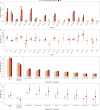Germline Sequencing DNA Repair Genes in 5545 Men With Aggressive and Nonaggressive Prostate Cancer
- PMID: 32853339
- PMCID: PMC8599772
- DOI: 10.1093/jnci/djaa132
Germline Sequencing DNA Repair Genes in 5545 Men With Aggressive and Nonaggressive Prostate Cancer
Abstract
Background: There is an urgent need to identify factors specifically associated with aggressive prostate cancer (PCa) risk. We investigated whether rare pathogenic, likely pathogenic, or deleterious (P/LP/D) germline variants in DNA repair genes are associated with aggressive PCa risk in a case-case study of aggressive vs nonaggressive disease.
Methods: Participants were 5545 European-ancestry men, including 2775 nonaggressive and 2770 aggressive PCa cases, which included 467 metastatic cases (16.9%). Samples were assembled from 12 international studies and germline sequenced together. Rare (minor allele frequency < 0.01) P/LP/D variants were analyzed for 155 DNA repair genes. We compared single variant, gene-based, and DNA repair pathway-based burdens by disease aggressiveness. All statistical tests are 2-sided.
Results: BRCA2 and PALB2 had the most statistically significant gene-based associations, with 2.5% of aggressive and 0.8% of nonaggressive cases carrying P/LP/D BRCA2 alleles (odds ratio [OR] = 3.19, 95% confidence interval [CI] = 1.94 to 5.25, P = 8.58 × 10-7) and 0.65% of aggressive and 0.11% of nonaggressive cases carrying P/LP/D PALB2 alleles (OR = 6.31, 95% CI = 1.83 to 21.68, P = 4.79 × 10-4). ATM had a nominal association, with 1.6% of aggressive and 0.8% of nonaggressive cases carrying P/LP/D ATM alleles (OR = 1.88, 95% CI = 1.10 to 3.22, P = .02). In aggregate, P/LP/D alleles within 24 literature-curated candidate PCa DNA repair genes were more common in aggressive than nonaggressive cases (carrier frequencies = 14.2% vs 10.6%, respectively; P = 5.56 × 10-5). However, this difference was non-statistically significant (P = .18) on excluding BRCA2, PALB2, and ATM. Among these 24 genes, P/LP/D carriers had a 1.06-year younger diagnosis age (95% CI = -1.65 to 0.48, P = 3.71 × 10-4).
Conclusions: Risk conveyed by DNA repair genes is largely driven by rare P/LP/D alleles within BRCA2, PALB2, and ATM. These findings support the importance of these genes in both screening and disease management considerations.
© The Author(s) 2020. Published by Oxford University Press. All rights reserved. For permissions, please email: journals.permissions@oup.com.
Figures


References
-
- Bray F, Ferlay J, Soerjomataram I, et al. Global cancer statistics 2018: GLOBOCAN estimates of incidence and mortality worldwide for 36 cancers in 185 countries. CA Cancer J Clin. 2018;68(6):394–424. - PubMed
-
- Siegel RL, Miller KD, Jemal A. Cancer statistics, 2020. CA Cancer J Clin . 2020;70(1):7–30. - PubMed
-
- Hemminki K, Ji J, Forsti A, et al. Concordance of survival in family members with prostate cancer. J Clin Oncol. 2008;26(10):1705–1709. - PubMed
-
- Brandt A, Sundquist J, Hemminki K. Risk for incident and fatal prostate cancer in men with a family history of any incident and fatal cancer. Ann Oncol. 2012;23(1):251–256. - PubMed
-
- Jansson KF, Akre O, Garmo H, et al. Concordance of tumor differentiation among brothers with prostate cancer. Eur Urol. 2012;62(4):656–661. - PubMed
Publication types
MeSH terms
Grants and funding
LinkOut - more resources
Full Text Sources
Medical
Molecular Biology Databases
Research Materials
Miscellaneous

